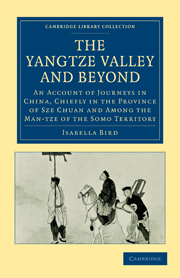 The Yangtze Valley and Beyond
The Yangtze Valley and Beyond Book contents
- Frontmatter
- PREFACE
- Contents
- LIST OF ILLUSTRATIONS
- ERRATA
- CHAPTER I GEOGRAPHICAL AND INTRODUCTORY
- CHAPTER II “THE MODEL SETTLEMENT”
- CHAPTER III HANGCHOW
- CHAPTER IV THE HANGCHOW MEDICAL MISSION HOSPITALS
- CHAPTER V SHANGHAI TO HANKOW (HANKAU)
- CHAPTER VI THE FOREIGNERS—HANKOW AND BRITISH TRADE
- CHAPTER VII CHINESE HANKOW (HANKAU)
- CHAPTER VIII HANKOW TO ICHANG
- CHAPTER IX ICHANG
- CHAPTER X THE UPPER YANGTZE
- CHAPTER XI RAPIDS OF THE UPPER YANGTZE
- CHAPTER XII RAPIDS AND TRACKERS
- CHAPTER XIII LIFE ON THE UPPER YANGTZE
- CHAPTER XIV THE YANGTZE AND KUEI FU
- CHAPTER XV NEW YEAR'S DAY AT KUEI-CHOW FU
- CHAPTER XVI KUEI FU TO WAN HSIEN
- CHAPTER XVII CHINESE CHARITIES
- CHAPTER XVIII FROM WAN HSIEN TO SAN TSAN-PU
- CHAPTER XIX SZE CHUAN TRAVELLING
- CHAPTER XX SAN-TSAN-PU TO LIANG-SHAN HSIEN
- CHAPTER XXI LIANG-SHAN HSIEN TO HSIA-SHAN-PO
- CHAPTER XXII HSIA-SHAN-PO TO SIAO-KIAO
- CHAPTER XXIII SIAO-KIAO TO HSIEH-TIEN-TZE
- CHAPTER XXIV HSIEH-TIEN-TZE TO PAONING FU
- CHAPTER XXV PAONING FU AND SIN-TIEN-TZE
- CHAPTER XXVI SIN-TIEN-TZE TO TZE-TUNG HSIEN
- CHAPTER XXVII TZE-TUNG HSIEN TO KUAN HSIEN
- CHAPTER XXVIII KUAN HSIEN AND CHENGTU
- CHAPTER XXIX KUAN HSIEN TO SIN-WEN-PING
- CHAPTER XXX SIN-WEN-PING TO LI-FAN TING
- CHAPTER XXXI LI-FAN TING TO TSA-KU-LAO
- CHAPTER XXXII THE “BEYOND”
- CHAPTER XXXIII THE MAN-TZE, I-REN, OR SHAN-SHANG-REN
- CHAPTER XXXIV FROM SOMO TO CHENGTU FU
- CHAPTER XXXV DOWNWARD BOUND
- CHAPTER XXXVI LUCHOW TO CHUNG-KING FU
- CHAPTER XXXVII THE JOURNEY'S END
- CHAPTER XXXVIII THE OPIUM POPPY AND ITS USE
- CHAPTER XXXIX NOTES ON PROTESTANT MISSIONS IN CHINA
- CONCLUDING REMARKS
- ITINERARY
- APPENDICES
- INDEX
- Plate section
CHAPTER XXXIX - NOTES ON PROTESTANT MISSIONS IN CHINA
Published online by Cambridge University Press: 05 July 2011
- Frontmatter
- PREFACE
- Contents
- LIST OF ILLUSTRATIONS
- ERRATA
- CHAPTER I GEOGRAPHICAL AND INTRODUCTORY
- CHAPTER II “THE MODEL SETTLEMENT”
- CHAPTER III HANGCHOW
- CHAPTER IV THE HANGCHOW MEDICAL MISSION HOSPITALS
- CHAPTER V SHANGHAI TO HANKOW (HANKAU)
- CHAPTER VI THE FOREIGNERS—HANKOW AND BRITISH TRADE
- CHAPTER VII CHINESE HANKOW (HANKAU)
- CHAPTER VIII HANKOW TO ICHANG
- CHAPTER IX ICHANG
- CHAPTER X THE UPPER YANGTZE
- CHAPTER XI RAPIDS OF THE UPPER YANGTZE
- CHAPTER XII RAPIDS AND TRACKERS
- CHAPTER XIII LIFE ON THE UPPER YANGTZE
- CHAPTER XIV THE YANGTZE AND KUEI FU
- CHAPTER XV NEW YEAR'S DAY AT KUEI-CHOW FU
- CHAPTER XVI KUEI FU TO WAN HSIEN
- CHAPTER XVII CHINESE CHARITIES
- CHAPTER XVIII FROM WAN HSIEN TO SAN TSAN-PU
- CHAPTER XIX SZE CHUAN TRAVELLING
- CHAPTER XX SAN-TSAN-PU TO LIANG-SHAN HSIEN
- CHAPTER XXI LIANG-SHAN HSIEN TO HSIA-SHAN-PO
- CHAPTER XXII HSIA-SHAN-PO TO SIAO-KIAO
- CHAPTER XXIII SIAO-KIAO TO HSIEH-TIEN-TZE
- CHAPTER XXIV HSIEH-TIEN-TZE TO PAONING FU
- CHAPTER XXV PAONING FU AND SIN-TIEN-TZE
- CHAPTER XXVI SIN-TIEN-TZE TO TZE-TUNG HSIEN
- CHAPTER XXVII TZE-TUNG HSIEN TO KUAN HSIEN
- CHAPTER XXVIII KUAN HSIEN AND CHENGTU
- CHAPTER XXIX KUAN HSIEN TO SIN-WEN-PING
- CHAPTER XXX SIN-WEN-PING TO LI-FAN TING
- CHAPTER XXXI LI-FAN TING TO TSA-KU-LAO
- CHAPTER XXXII THE “BEYOND”
- CHAPTER XXXIII THE MAN-TZE, I-REN, OR SHAN-SHANG-REN
- CHAPTER XXXIV FROM SOMO TO CHENGTU FU
- CHAPTER XXXV DOWNWARD BOUND
- CHAPTER XXXVI LUCHOW TO CHUNG-KING FU
- CHAPTER XXXVII THE JOURNEY'S END
- CHAPTER XXXVIII THE OPIUM POPPY AND ITS USE
- CHAPTER XXXIX NOTES ON PROTESTANT MISSIONS IN CHINA
- CONCLUDING REMARKS
- ITINERARY
- APPENDICES
- INDEX
- Plate section
Summary
Two thousand four hundred and fifty-eight Protestant workers (including wives) represent the missionary energies and the many divisions of Christendom. The native Protestant communicants number 80,632.
The shock which China received through her defeat by Japan has produced, among other results, a disposition to make inquiries regarding the God, faith, and learning of those “Western Barbarians” from whom Japan received the art of war. Although hostility to Christianity as a destructive and socially disintegrating power has been recently evidenced by the anti-Christian riots at Kien-ing and elsewhere, the spirit of inquiry gathers volume, and expresses itself in large gatherings in street-chapels and churches, the thronging to mission schools, and the avidity with which Christian literature is purchased. Those who profess themselves ready to abandon heathenism and connect themselves with Christianity are more than the missionaries can instruct. In Manchuria there are six thousand inquirers in connection with the Scotch and Irish missions. In the Fu-kien province the movement towards Christianity is on so extensive a scale as to attract the serious attention of the provincial authorities, as well as emphatic recognition by our own consuls. In one mission alone of the American Board, in another province, the number of inquirers into the Christian religion is estimated at 12,000.
The growing influence of Christianity, however, cannot be measured either by the numbers of communicants or inquirers.
- Type
- Chapter
- Information
- The Yangtze Valley and BeyondAn Account of Journeys in China, Chiefly in the Province of Sze Chuan and Among the Man-tze of the Somo Territory, pp. 518 - 529Publisher: Cambridge University PressPrint publication year: 2010First published in: 1899


